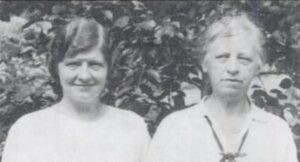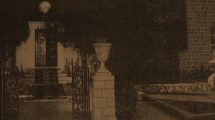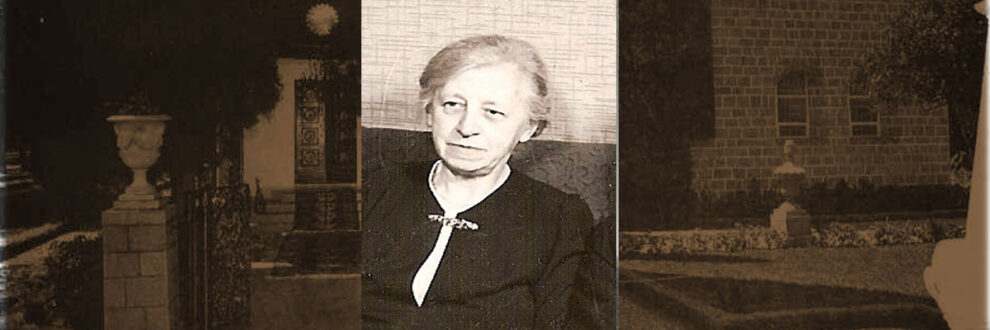 Johanna (Christensen) Schubarth
Johanna (Christensen) Schubarth
Born:1877
Death:December 1, 1952
Place of Birth:Sandefjord, Norway
Location of Death:Oslo, Norway
Burial Location: Western Cemetery at the foot of Holmenkollen mountain on the outskirts of Oslo, Norway
Johanna (Christensen) Schubarth is called the “Mother Bahá’í of Norway”. She learned of the Bahá’í Faith from May Maxwell in 1919. She returned to Norway in 1927.
“Johanna Schubarth, by virtue of her sacrificial services to the Faith over such a long period of time, has attained a very high station. She is the mother of the Norwegian Baha’i Community, and is the founder of the Faith in that country. She served diligently under adverse conditions, and all alone, for many years, kept the light of the Faith aflame, single handed. She was a very rare soul, was entirely consecrated to the Faith and completely devoted to its service.
Only future generations will be able to properly appraise the value of the great service which she has rendered at such a critical time in the history of the Faith, and under such difficult conditions…”
“The Guardian wishes to make clear the importance of the station of Johanna Schubarth, as she was the founder of the Baha’i Community in Norway, and thus her station is higher than that of a pioneer. .. .” – From Letter of the Guardian through his Assistant Secretary, dated March 11, 1953
These words, written at the direction of Shoghi Effendi, Head of the Baha’i World Faith, established for all time the station of Johanna Christensen Schubarth.
Her family was employed in a business where large whaling vessels were built and repaired. Her great grandfather had a large boat in which he would go out to help ships in danger and distress. Her father, a ship leader, did not come back one day and nothing was ever heard of him or his ship. Thus a family of eighteen children, with “plenty of sons,” was left fatherless. Her mother married a second time and it was decided that the younger children should become known by the name of their second father. So it was that Johanna’s name became Schubarth.
As a little girl, Johanna watched the “diggings” of the Gogstad ship, a Viking ship so called because it was on the Gogstad farm near where Johanna lived that this fine specimen was found. Viking ships were used as burial places for kings and queens, were buried deep in the ground and covered with a special sand to preserve them. Johanna watched as this one was taken out of the earth, piece by piece, and sent off to the University of Oslo where it was studied and reassembled. It is now one of the two chief exhibits at the Viking Museum [Vikingshusell] in Oslo. Johanna’s aunt, Hilde Christensen became interested in the beautiful designs and colors in the old fabrics found in the Viking ships, and through scientific study was able to reproduce the colors. Her books on this subject have become classics. Johanna went to the United States to pursue her profession of nursing and it was through a patient in Urbana, Illinois, that she first heard of the Baha’i Faith. She withdrew from her work as a nurse for a period of six months in order to study the Faith thoroughly before she fully accepted it. It was through May Maxwell that she received her confirmation and declared herself in 1919.
In 1927 Johanna returned to Norway to nurse her mother, and on her way she was privileged to visit Haifa. There she had daily talks with the Guardian, Johanna asking questions, the Guardian answering and explaining things to her. Shoghi Effendi asked her to remain in Oslo and spread the Teachings. There were no other Baha’is in Norway then, and there was no Baha’i literature in Norwegian.

Johanna put her will in the Hands of God and was guided in all her work by Baha’u’llah and the beloved Guardian. Although she would have liked very much to return to the United States, she remained in Oslo and began translating the Baha’i Writings into Norwegian. Desiring to give the remainder of her life to work for the Baha’i Faith and feeling that the translation of the Writings would be her greatest gift, she studied the language and took the University examination at the age of fifty or more years. She agonized over getting into her native language the spiritual depths in the Words of Baha’u’llah. “There is no way to express these things in Norwegian,” she would say, but somehow she brought their expression forth. She was always working on some manuscript of translation from the Writings, even after she became crippled with arthritis and could devote only a few minutes at a time to it during the last two years of her life.
When the European Teaching Committee began its work in Norway in 1946, as part of the unfoldment of the Divine Plan of ‘Abdu’l-Baha in the Second Seven-Year Plan, there were ready in Norwegian, thanks to Johanna’s efforts, Esslemont’s book, in print and on sale in one of the large book shops of Oslo; translations of The Hidden Words, the Words of Wisdom, and, in manuscript form, the Kitab-i-Iqan of Baha’u’llah, many Baha’i prayers, and The Will and Testament of ‘Abdu’l-Baha.
Soon afterward came translations of Shoghi Effendi’s The Goal of a New World Order and the compilation Baha’i Community. Later, in cooperation with the Norwegian Translating Committee, Johanna contributed the lion’s share to translations of papers on “The Covenant” and “Comparative Religion” read at the Summer School held in connection with the European Teaching Conference at Copenhagen (Elsinore) in 1950. Johanna also helped with the translation of David Hofman’s The Renewal of Civilization.
The respect in which Johanna was held in Oslo, her friendship of many years’ standing with Johanna Sorensen, now Mrs. Dr. Hoeg of Herning, Denmark, and above all, her staunch devotion and utter self-sacrifice to the slightest wish of the beloved Guardian, all greatly aided the work of the continuous promotion of the Faith in this northern country.
Johanna Schubarth lived in Oslo in a large room which was flooded with sunlight when there was sun. It was on the third floor of an old building, up a winding wooden staircase. The only heat in the room during the long, dark, cold winters was from a large tile stove for which coal had to be lugged from the basement. During the war years there was no coal. Wishing to serve her countrymen in these difficult times, Johanna took up again her profession of nursing, volunteering her services. She received a citation from the King of Norway for her work but her health was broken by the deprivations and sufferings she had endured.
In 1947 all food was still rationed in Norway but as a retired nurse, Johanna was able to receive a few eggs a month and some milk. Every food package sent her from the United States was carefully stretched as far as it would go, and the choicest items saved for the Nineteen Day Feasts held in her apartment. Some of the friends wished to provide Johanna with a supply of coal as soon as it became possible to buy a little at a time, but she would not permit it, refusing to sign the papers necessary to get it delivered. She would live and serve to the utmost of her ability and strength, but would take care of herself, her heritage from ancestors used to the rigors of whaling would not permit anything else.
During the twenty years that Johanna Schubarth “held aloft the light of the Faith” in Norway, the visits of Baha’i itinerant teachers and visitors brought high lights to her days. Always, at train or ship, she went to meet them, to welcome them, and to bid them farewell; whatever the time of day or night, or however cold the weather, her spiritual and radiant face shone out from the crowd. Among these teachers was Martha Root, termed by the Guardian “that archetype of Baha’i itinerant teachers,” who in 1935 visited the Scandinavian countries. In the last days of Johanna’s life she was made radiantly happy and brought close to the beloved Guardian through the visit of Zhikrullah Khadem, Hand of the Cause of God, and his lovely wife.
At the beginning of the Second Seven Year Plan, Johanna’s joy was great when she welcomed the pioneers sent to Norway by the European Teaching Committee of the National Spiritual Assembly of the United States. To these pioneers she was ever a source of strength and comfort. It was not easy, after so many years of working alone, suddenly to work with others, but she achieved this transition because of her love for the Guardian and her selfless obedience to the Administration. Great was her joy in the firm establishment of the Faith with the formation of the first local Assembly in Norway, the Spiritual Assem- bly of Oslo, in April, 1948. As chairman of that Spiritual Assembly she presided at the first public meeting held in Oslo, in January, 1950. In July of the same year, she rejoiced to be able to attend the European Teaching Conference held in Copenhagen, together with every member of the Oslo Baha’i Community.
On December 1, 1952 Johanna Schubarth passed away in a hospital in Oslo. The Scandinavian Baha’i Bulletin for January 1953, carried an article in tribute to her, written by Mrs. Asta Barnholdt, an old friend and a Baha’i, which said in part:
“The Oslo Baha’i Community therewith lost the foundation stone in the promotion of the Faith in Norway…Johanna’s life and person testified to her wholesome character. Great words and violent feelings were unknown to her. We knew her as a person who radiated purity, simplicity, justice and stability. Her great love for the Faith which she had accepted, we shall never forget! Nor her goodness and helpfulness to all! …”
Johanna was quiet, reserved, shy, a “doer” and not a “talker.” As the unfoldment of the Faith progressed in this new community and it formed the base for an ever-widening teaching work, Johanna was a bulwark of firmness around which temporary crises made no headway, and all felt in her strength, integrity and depth of understanding, the everlasting qualities of true faith.
In the communication from the Guardian dated March 11, 1953, he instructed “that as many friends as possible attending the Conference in Stockholm, make a special effort to travel there via Norway and to visit her grave. This refers not only to the Baha’is attending the Conference from America, but likewise those attending from the various parts of Europe.” Accordingly, in obedience to this request, many Baha’is from the United States, Persia and European countries gathered, in the days immediately preceding the Third Intercontinental Teaching Conference in July, 1953, as well as immediately after the Conference, to read prayers at the grave of “the founder of the Faith” in Norway.
 Johanna’s remains had been laid to rest, after a beautiful Baha’i service, in the Var Frelsers (Our Savior’s) Cemetery within the city of Oslo. In December, 1953, her remains were removed to the Vest Gravelund or Western Cemetery, at the foot of Holmenkollen mountain on the outskirts of Oslo, where, in her Will and Testament, it was found she had requested burial. “Only future generations will be able to properly appraise the value of the great service which she has rendered at such a critical time in the history of the Faith, and under such difficult conditions. . ..”[1]
Johanna’s remains had been laid to rest, after a beautiful Baha’i service, in the Var Frelsers (Our Savior’s) Cemetery within the city of Oslo. In December, 1953, her remains were removed to the Vest Gravelund or Western Cemetery, at the foot of Holmenkollen mountain on the outskirts of Oslo, where, in her Will and Testament, it was found she had requested burial. “Only future generations will be able to properly appraise the value of the great service which she has rendered at such a critical time in the history of the Faith, and under such difficult conditions. . ..”[1]
Source:
1 The Bahá’í World. Kidlington, Oxford: George Ronald Publisher. Volume XII pp 694-696; -Permission given by George Ronald, Publishers
Images:
Courtesy Bahá’ís of Norway





Add Comment